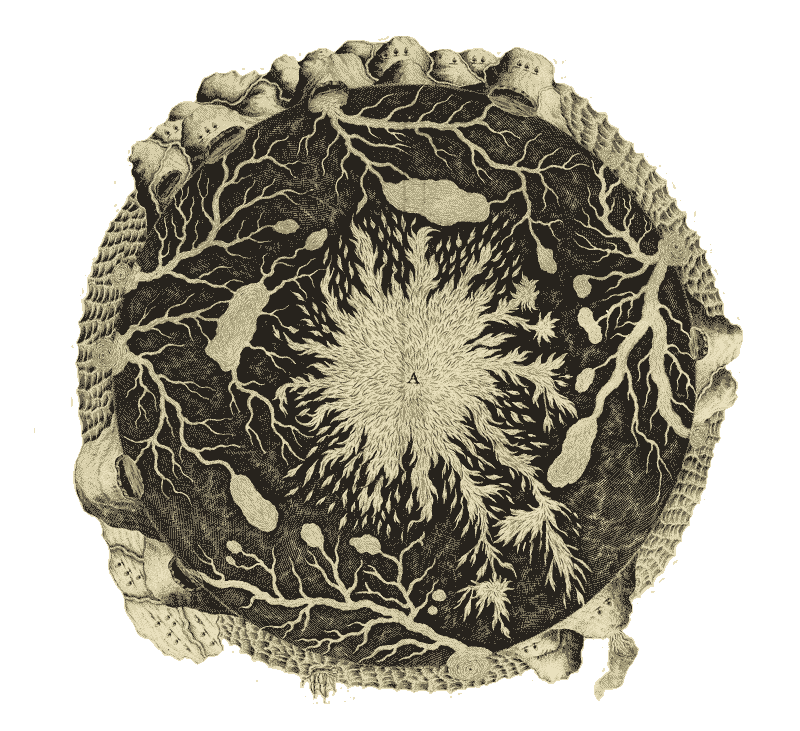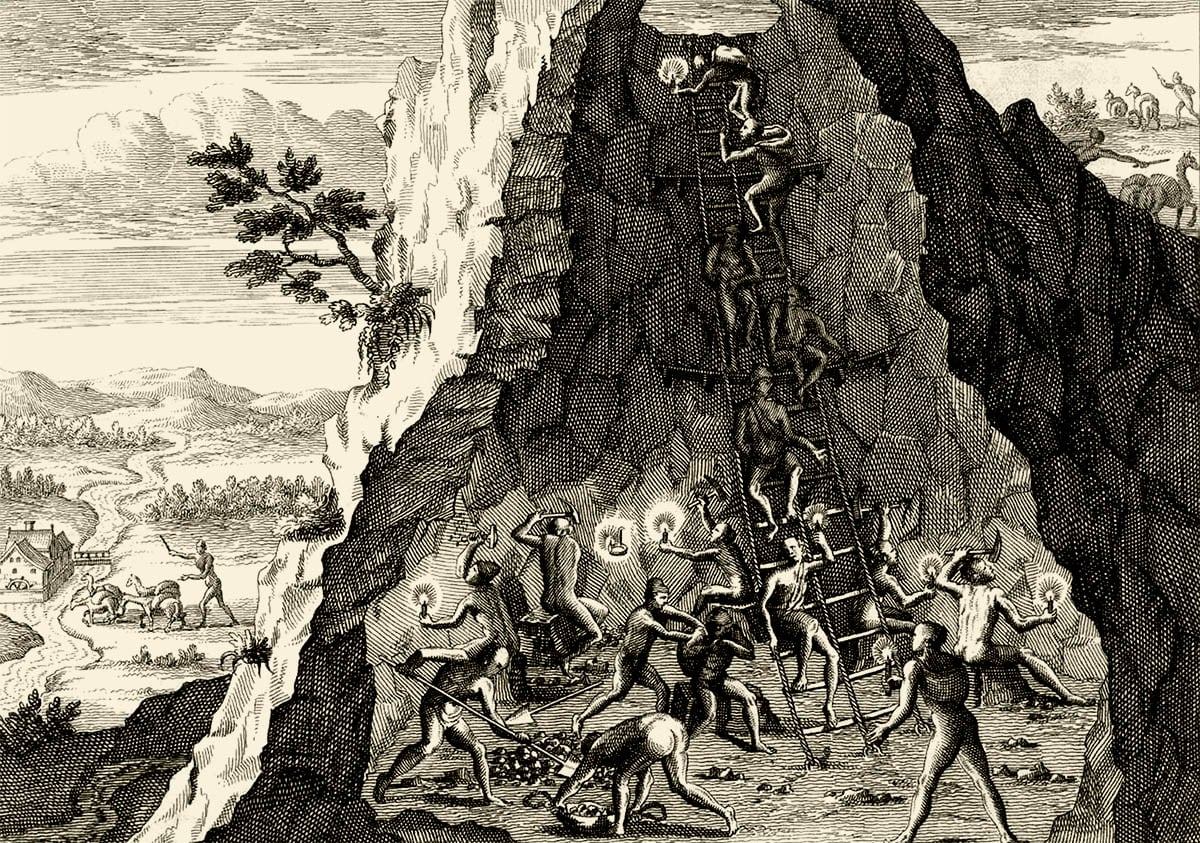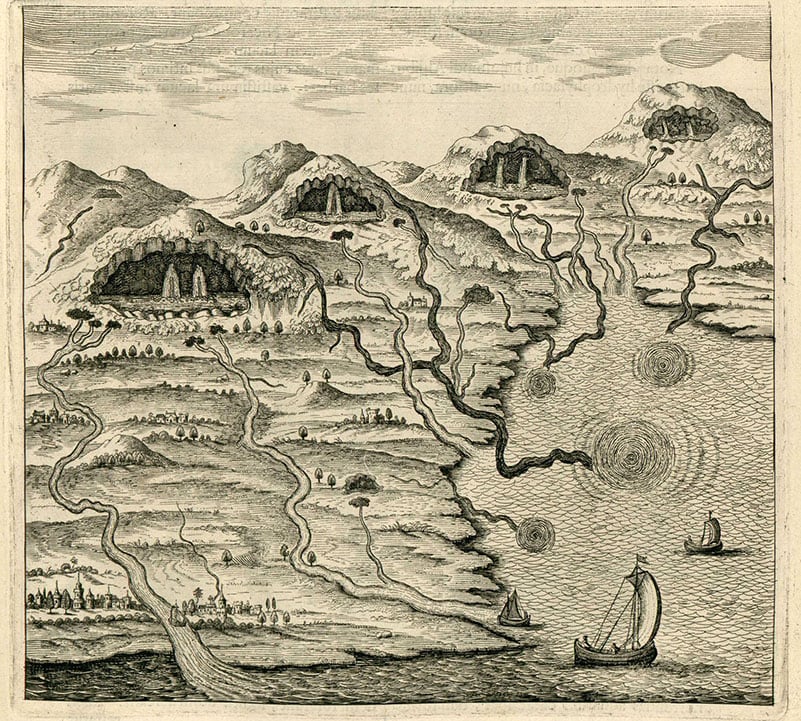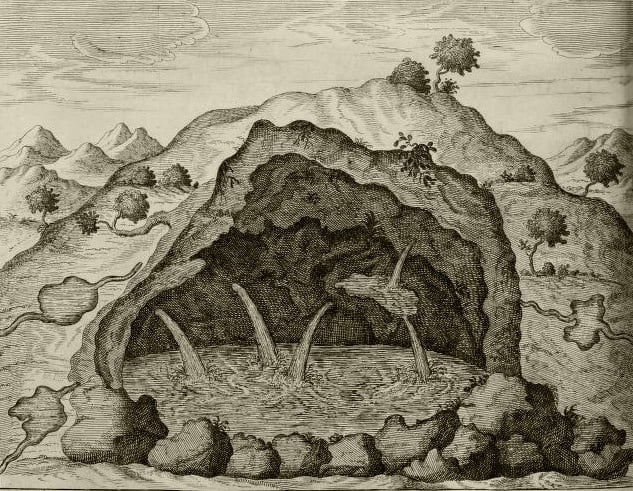Inner Force
A conversation about what moves us.

Shaped by the legacy of eighteenth- and nineteenth-century geological thinking, popular ideas of the underground replicate two primary figures: the mine and the cave. The mine, on the one hand, draws our senses to the physical challenges of extracting materials such as oil and gold from below the surface. It reminds us of massive global endeavors launched on the basis of exploited labor and environmental degradation to extract minerals and turn them into commodities so that people can decorate their bodies, build microchips, commit to monogamous relations, pass on the spirits of the ancestors, and generate vast profits. The cave, on the other hand, makes us marvel at the possibility of hollowed-out open space, usually beneath our reach, opening a form of geological proprioception. The cave allows us to expand our spatial imaginary (1). As anthropologists have shown, mines have been known to eat people, and caves are often sites for starting our journey to the afterlife. Together, they inspire visions of stratigraphic layers sprinkled with valuables; vertical dwellings that augment our sense of the inhabitable at a time when the planetary imagination reveals the world as a damaged place (2).

And yet, there is another type of subterranean figure, one that while partially sharing some elements with the cave and the mine also exceeds them. Hydrologists call it an aquifer, but I tend to think with hydrogeologists in Costa Rica who described it to me as a saturated sponge, a dynamic architecture sucking and seeping, swelling and shrinking, absorbing and oozing (3). Once my conversations with hydrogeologists from one of the state agencies dealing with underground water in Costa Rica moved past initial formalities, they repeatedly told me the same thing. Any time I asked questions about what aquifers were, they reminded me that, “To understand aquifers you need to understand movement. Subterranean water is nothing but movement.”

In Costa Rica, aquifers have recently moved from being a concern of a closed circle of government officials and drilling companies to a major preoccupation in environmental, agricultural, and real estate circles. Increasing conflicts around water access, the proliferation of accidents that taint the source of water of more than 85 percent of the country’s population, and the threat of privatization to sell water to the global north have turned aquifers into controversial formations. What until the end of the millennium politicians left quietly underground, today they pull up as critical for the future of the nation. Subterranean water has risen to prominence as a geopolitical token, an object of national security projects, and an irresistible riddle in planetary science.
Despite that renewed prominence, aquifers remain somewhat mysterious. They seem unremarkable until we stop to think about their form, and realize that we need to think water and stone together, inseparable, but also in constant movement. Aquifers are the movement that the encounter of water with rock makes possible; they are the seepage that their push and pull effects. Privileging movement, the difficult and never frictionless encounter between water and stone confounds our capacity to distinguish between figure and ground (4).
Many people in Costa Rica do not think of underground water as movement. They rather speak of aquifers as underground water veins. One precursor of the idea of a water vein is located in colonial times when Europeans combined Christian beliefs with mining endeavors (5). Matching the language of mineral mining with a particular appreciation of the body as a theological substrate resulted in the widespread idea that gold and silver are to be found in veins under the surface. From there, it was not hard to imagine subterranean water similarly. In contemporary Costa Rica, public sector scientists explain that their work consists of changing that notion. They want to efface the idea that an aquifer is a contained entity, like a vein or a pipe. They want to show the public its radically different form, as nothing more than a saturated substrate in movement. Their purpose is to call attention to how that particular form makes aquifers fragile, susceptible to pollution, and many times indocile to restoration and cleanup efforts after they have been tainted.
Attuning ourselves to this sense of what aquifers are changes the way we encounter elements. Rather than taking rock and water as distinct elements, aquifers push us to keep them together and to ask how doing so redefines what we consider as elemental. What if rather than imagining substances, we considered elemental choreographies? What if we described these choreographies as fields where subjects and substances are not willful or distinct, but constantly pushed and pulled in different directions. I am thinking here with feminist STS scholars who propose attending to the “dynamic coordination of the technical, scientific, kinship, gender, emotional, legal, political, and financial aspects” necessary to bring entities into sociomaterial presence (6).
But this choreography is not an orderly articulation between existing entities. It is seepage, outflow, ooze. It is a kind of movement where differentiating between figure and ground, water and stone, science and law, finance and emotion, is difficult. Perhaps the implication of this is that rather than thinking about the subsurface as the elemental ground for elemental substances, we can think of hydrolithic choreographies, the force-filled and ongoing push and pull of matter and beings. Thinking about this elemental pull redirects our ethnographic eyes to the forces that draw politics and bodies into the subsurface, into the midst of hydrolithic choreographies that we are all performing, most of the time without our willful approval. The question that emerges is how to reconfigure the elemental, moving away from our implicit comfort with thingness and closer to the intermittence of process, to a material-semiotic history that has always been jumpy and unpredictable.
The group of geologists that promote this elemental choreography do so following decades of community and environmental activism against open pit mining (7), pollution of aquifers by toxic chemicals used in plantations (8), and the allocation of water to luxury real estate developers in coastal areas (9). Those mobilizations have taken the country’s “spongy aquifers”(10) beyond the closed circles of government officials and well drilling companies where they remained during most of the 20th century. As we come to terms with aquifers as critical resources for the future of the Nation, as fragile formations under serious risk of pollution, and as the only option to adapt to the drought-stricken future that climate change brings, our spatial imaginaries need to change. We need more agile, dynamic images. Mental models that go beyond the obsession of thinking of the underground as a bank, a deep time vault where valuables are kept. Hydrolithic elemental choreographies seek alternative senses that can mobilize action.

As invitations to act, hydrolithic elemental choreographies resist dominant habits of thought, such as the separation between figure and ground, the emphasis on horizontal landscapes, and the presumed immobility of geologic layers. Furthermore, aquifers, geologists, and publics in Costa Rica invite us to think with push and pull, with the volumetric dynamics that keep us in connection with each other regardless of our willingness to do so. In this formation, we can make speakable an insurmountable mystery: the simultaneity of movement and fixity. In this formation, we can allocate responsibility for the future of water (11) in a more precise manner.
As you read this piece, consider how your feet touch the floor, the ground. If you are sitting on a chair with legs or wheels, consider how it touches the ground. If you are lying on a bed or on the grass, how does your surface touch the underground’s surface? That intimate touch is itself a point of choreographed contact with worlds underneath. That point of contact, seemingly ephemeral and punctuated, is a point of contact in the choreography of movement that shapes our lives. It reminds all of us how we always move with and against gravity, rock, and perhaps unknowingly, water. How might this awareness of our choreographed selves, as bodies that have always moved, as bodies always at the verge of movement (even when we stand still), reopen our sense of presence? Presence, as movement.

